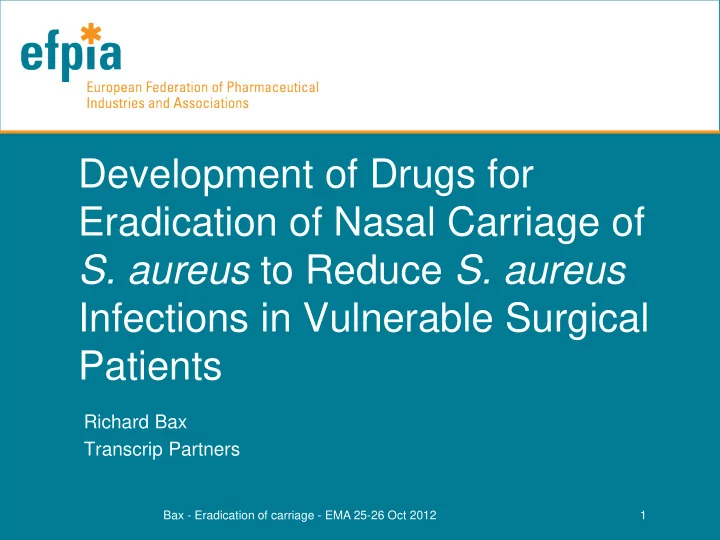

Development of Drugs for Eradication of Nasal Carriage of S. aureus to Reduce S. aureus Infections in Vulnerable Surgical Patients Richard Bax Transcrip Partners Bax - Eradication of carriage - EMA 25-26 Oct 2012 1
Agenda for this talk – Context • Importance of carriage • Challenge of clinical trials • Possible label wording – Ways to go forward • What is eradication? • What is the impact of eradication? • Next steps? Bax - Eradication of carriage - EMA 25-26 Oct 2012 2
Context Eradication of carriage • Nasal/gut colonization with pathogens is common – S. aureus, N. meningitidis, H. pylori, C. difficile, gut flora (selective decontamination), MDR Pathogens – Logically, you can’t get infected if the pathogen is not present • There are precedents for this concept – nasal mupirocin: S. aureus/ MRSA/MSSA – oral ciprofloxacin/rifampicin: N. meningitidis – oral clarithromycin/amoxicillin/metronidazole: H. pylori • Regulatory focus going forward on proven clinical benefit over and above successful eradication (draft guideline 4.2.1.5.4) • Focus for this talk: S. aureus decolonization 3 Bax - Eradication of carriage - EMA 25-26 Oct 2012
Context S. aureus nasal eradication • Premise: S. aureus nasal carriage is an important risk factor for infection due to S. aureus 1,2 in high risk patients • Control of MRSA/MSSA remains a challenge – Mupirocin resistance is rising • New agents are needed: – How can we achieve this? – Trials based on clinical endpoints are not possible (next slide)… 1. Munoz et al . J Hosp Inf 2008; 68: 25-31 2. Kluytmans et al . Infection 2005; 33: 3-8 4 Bax - Eradication of carriage - EMA 25-26 Oct 2012
Context S. aureus nasal eradication: Sample sizes for a trial powered on clinical benefit are in the thousands Total Number of Screening Subjects 60% reduction 50% reduction 40% reduction Scenario: 100,000 - 25% screened = nasal S.aureus 90,000 carriers 80,000 - 2% placebo infection rate post-op 70,000 - objective: 50% reduction of infections 60,000 - 90% power, two-sided type-1 error 5% 50,000 40,000 → 26,400 subjects 30,000 20,000 required to show 50% 10,000 0 event reduction 2% 1% 3% 4% 5% 6% 7% 8% 35,064 17,408 11,528 8,584 6,816 5,640 4,800 4,168 60% reduction 53,200 17,472 13,008 10,328 8,544 7,264 6,304 50% reduction 26,400 40% reduction 87,328 43,320 28,656 21,320 16,920 13,984 11,888 10,320 Slide from EFPIA Post-surgery infection rate in placebo group presentation at Feb 2011 EMA guidance workshop Bax - Eradication of carriage - EMA 25-26 Oct 2012 5
Labelling as a view to the problem • But, the point of any such product is to prevent infection • So, how do we go from this… – Bactroban nasal is indicated for the eradication of nasal colonisation with MRSA in adult patients and health care workers as part of a comprehensive infection control programme to reduce the risk of infection among people in high risk of MRSA infection during institutional outbreaks of infections with this pathogen. • To this? – Product X is indicated for the eradication of nasal colonisation with staphylococci including MRSA to reduce the risk of post operative staphyloccal infections in high risk patients. Bax - Eradication of carriage - EMA 25-26 Oct 2012 6
Ways to go forward What is eradication? • The possible tools are well known – Culture, PCR, etc • Can we work together to validate some measure of microbiological eradication as reliable predictor of clinical benefit? – Review previous successful papers and micro methodologies and agree microbiological methods – Focus on tools that offer high face validity, long track records, and wide-spread availability – Also think through issues of measurement timing / duration Bax - Eradication of carriage - EMA 25-26 Oct 2012 7
Ways to go forward What is the impact of eradication? • Logically, there must be an impact – If the organism is eradicated, endogenous infection is not possible • How do we decide? – Collective review of available data – Workshop-based discussion and analysis • Goals of this work – Summarize and agree interpretation of available data – Where needed, generate plans for additional research – Also identify possible negative effects of decolonization • In so doing, create a road-map for development Bax - Eradication of carriage - EMA 25-26 Oct 2012 8
Next Steps • New agents for S. aureus decolonization are needed • Eradication logically should offer value – Need to define methods and value. • Existing data are probably adequate to show that value • We would like to find a way to create a public conversation on this that enables future work Bax - Eradication of carriage - EMA 25-26 Oct 2012 9
Recommend
More recommend